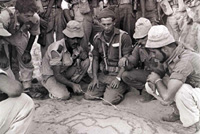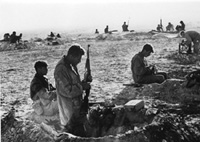|
|

Sinai Campaign |

|
| |
 
|
| |
The Sinai Campaign, fought to put an end to to the terrorist incursions into Israel and to remove the Egyptian blockade of Eilat, marked the final transformation of the IDF into a professional army capable of large-scale operations. A battle plan for the operation was adopted in early October 1956, but was revised following Israel's secret agreement with Britain and France. Under this agreement, Israel would transfer the focus of action as close to the Suez Canal as possible. On its own account, the Israeli government also drew up a course of action allowing it to convert the operation into a brief raid, should the British and French, contrary to the secret agreement, not intervene. In a new plan, adopted on October 25.
it was decided to launch the operation with aparatroop landing, and to hold the Armored Corps back until October 31. At 17:00 on October 29, Israeli units parachuted into the eastern approaches of the Mitla Pass near the Canal - a political rather than tactical or strategic objective. The action provided the pretext for a French and British ultimatum to Israel and Egypt, calling on both sides to cease hostilities and withdraw from the Canal area. For diversionary reasons, Israeli forces also advanced on southern and central axes. The following day, October 30, Britain and France issued the planned ultimatum, but to no effect, as heavy fighting between Egyptian and Israeli units persisted. By November 5, all of Sinai was in Israeli hands. The Sinai Campaign did not so much introduce new principles and policies as reaffirm the direction the IDF had already taken. Above all, the doctrine that the determining factors in Israel's mode of warfare would be the Armored Corps and the Air Force was confirmed. |
 |